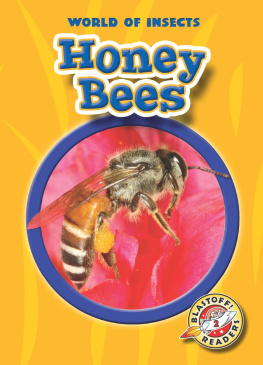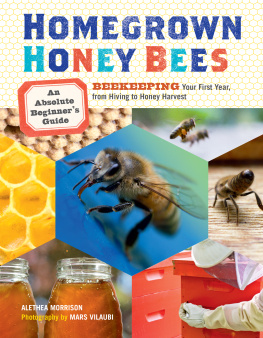
Praise for Healthy Bee, Sick Bee
If you want to learn about popping bee penises (and honestly, who doesnt), and where not to get stung, then this is the book to read. But obviously this book contains much more than a string of very amusing anecdotes. Phil Lester not only shows us his love of honey bees, but also his deep knowledge of everything that plagues them. I can easily see Healthy Bee, Sick Bee becoming the go-to-book for anyone interested in honeybees and their demons, large and small. Highly recommended. Prof Madeleine Beekman, School of Life and Environmental Sciences, University of Sydney
Lesters book is an impeccably researched analysis of the health of the honey bees of New Zealand by one of the worlds greatest bee pathologists. Lester pulls no punches when discussing controversial topics like the effects of neonicotinoids on bees, or the (un)likelihood of eradicating AFB from New Zealand. Packed with anecdote and cautionary tales, the story is told with immense style. This will be a valuable resource for beekeeper and scientist alike. Prof Ben Oldroyd, School of Life and Environmental Sciences, University of Sydney
Praise for The Vulgar Wasp
Lester cleverly weaves facts and figures on the astonishing science of this little-loved insect into a text thats tickled with memorable anecdotes and personable insights. If you thought wasps were pointless, boring and unimportant, think again. Dr Seirian Sumner, Reader in Behavioural Ecology at University College London
The Vulgar Wasp is more than just interesting and instructive; its a delight to read. Its packed full of up-to-date information on invasive wasps in New Zealand and elsewhere, as well as in their native range all presented in an engaging, humorous and informative manner. Everything you might want to know about the life cycle of wasps, methods of control, and the environmental, social and economic costs of these pesky invertebrates can be found in this enormously readable book. Dr Andrea Byrom, Director of New Zealands Biological Heritage National Science Challenge


Victoria University of Wellington Press
PO Box 600 Wellington
vup.wgtn.ac.nz
Copyright Phil Lester 2020
First published 2020
This book is copyright. Apart from any fair dealing for the purpose of private study, research, criticism or review, as permitted under the Copyright Act, no part may be reproduced by any process without the permission of the publishers.
The moral rights of the author have been asserted.
A catalogue record for this book is available from the National Library of New Zealand.
ISBN 9781776564057 (print)
ISBN 9781776563746 (EPUB)
ISBN 9781776563753 (Kindle)
Ebook conversion 2020 by meBooks
The happiness of the bee and the dolphin is to exist. For man it is to know that and to wonder at it.
Jacques-Yves Cousteau
CONTENTS
What kills honey bees?
Democratic decisions and the occasional coup dtat
A parasite that gives (viruses) as well as takes (blood and fat)
Manmade, global pandemics in our favourite insect species
My hive smells fishy now Im obliged to burn my bees
Fungal, trypanosomatid and other parasites and pathogens
How do neonicotinoids, Roundup, organic pesticides and other chemicals affect honey bees?
Ants, small hive beetles, hornets wasps and a plethora of other predators
A lot of things affect bee health and sometimes populations collapse

Honey bees are essential to our agricultural and horticultural industries.
Pasture crops like clover and alfalfa need bee pollination. Photo: Phil Lester
What kills honey bees?
If the bee disappeared off the face of the Earth, man would only have four years left to live. That quote is widely attributed to Albert Einstein. Its the sort of substantial and big-picture statement that this impressive man could have made, but there is no actual evidence that he said it.
Without a doubt, however, bees and other pollinators are extraordinarily important. We depend on pollination for much of our food. A research group from Europe estimated that the economic value of pollination worldwide amounted to 153 billion. Vegetables and fruits were the leading benefactors of insect pollination, followed by edible oil crops, stimulants, nuts and spices. Beef and dairy production is heavily reliant on forage pollination by insects. Pollinators have been estimated to contribute to 9.5% of the total value of the production of human food worldwide. A total of 87 of the 115 leading global food crops are dependent upon animal pollination, and those animals are mostly bees.
Of all the bee pollinators, the western honey bee or European honey bee, Apis mellifera, is the most economically valuable in cropping systems around the world. Without honey bees, the yields of many fruit, nut and seed crops would drop by more than 90%.

A worker (female) bee. Note the large hind legs, which are well-suited to transporting pollen. Photo: Phil Lester
In 1984, in an experiment designed by a high-school student, two complete colonies of honey bees, each with around 3400 workers and a queen, were blasted into orbit on the space shuttle Discovery. For some strange reason NASA officials deemed dead bees to be the primary concern for human health on this trip, so the enclosure containing the bees was given a filtration system to address concerns about hazards posed by dead bees. All 6800 bees on board were allowed to keep their stingers, and attempts were made to provide nicer in-flight meals for them and a degree of stimulation. The bees needed a day or two in space to get used to zero gravity. By the end of the seven-day orbit, they had adjusted to their new environment and showed complete adaptation to microgravity. They flew from place to place. They built wax comb and the queens laid eggs. Crew members noted that bees were able to learn and adjust their flight behaviour to efficiently move around the colony. All but 350 of the 6800 bees survived the trip. No doubt to the great relief of NASA, the 350 deceased bees didnt seem to have affected astronaut health. This rate of bee (and astronaut) mortality would be about what youd expect from bee colonies of this size on Earth over a week-long period.

A drone (male) bee. The drone is much stockier than the worker, with large thoracic muscles powering the wings, and large eyes which help the bee to spot virgin queens in drone congregation areas. Photo: Phil Lester

Top: Astronaut C. Gordon Fullerton with insects, March 1982. Moths, flies and 14 bees were studied during an eight-day flight on the space shuttle
Next page














